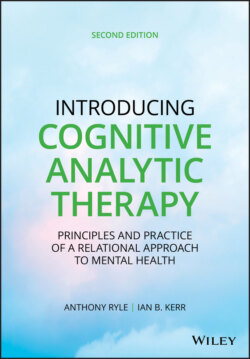Читать книгу Introducing Cognitive Analytic Therapy - Anthony Ryle - Страница 56
Developmental Studies of Role Acquisition
ОглавлениеThe key importance of RRs in CAT theory was first fully presented in Ryle (1985). However, it was derived from early work with the dyad grid and from clinical experience and was discussed prior to the evolution of CAT as such (Ryle, 1975). This involved in particular a restatement of ideas put forward by Ogden (1983). From a quite different background (see also Boyes, Guidano, & Pool, 1997; Cox & Lightfoot, 1997), the basic importance of RRs in early development are described by Oliviera (1997, p. 116) in her summing‐up of a detailed and sensitive Vygotskian study of interactions between children in day care aged between 1 and 6. She writes: “From birth, the child is involved in social matrices in which meanings are constructed in each baby–caregiver dyad. Then, in the dynamic process of coordination of the roles that the partners assume in the here‐and‐now situation, a confrontation of needs, goals and senses is created. While playing roles … the individual has to follow, not necessarily in a conscious manner, a way of acting that involves complex abilities, dealing with postures, gestures and emerging representation… Children become able to master several role relationships … while interacting with others with their own and maybe opposite intentions. The as‐if atmosphere created in symbolic play and in other situations … allows them to examine and modify some rules and images mediating their interactions.”
Oliviera's study traced the development of forms of collaboration from the 1‐year‐old's use of expressive gestures and reciprocal imitation through the creation by 2‐to‐4 year‐olds of “a collage of fragments of experiences” integrated by a range of signs or “starters,” including the use of language to take turns and reverse roles. Between 4 and 6 this “memory in action” is increasingly replaced by speech and by rule‐governed playing as the process of alternate imitation and reciprocation continues.
Oliviera's paper serves as a reminder of the extent to which other children are involved in the acquisition of RRs, but it is important to recognize the particular power of parents who may impose rather than negotiate their RR patterns and who have the power to define the agenda. The parents' personal restrictions and distortions may create idiosyncratic and confusing patterns and they may be unable to supply mediating concepts with which to make sense of some aspects of reality. This last point can be underlined by paraphrasing Vygotsky as follows: “what the child does not do or say with the adult today she will not do or say on her own tomorrow.”
Further evidence for the powerful way in which observed and experienced role enactments are internalized and re‐enacted by children comes from a fascinating projective test known as the “the teddy bears’ picnic” developed by Mueller (1996). In this test, young children are asked to describe what would happen next during a story about a picnic, using teddy bears and props such as a cart and picnic basket. The range of responses to imaginary situations, such as the cart getting a puncture, is remarkable. In the case of “daddy” teddy bear, for example, the child may describe a calm, reassuring, and problem‐solving response or, at the other extreme, an angry and abusive outburst directed toward “mummy.” These results correlate well with the quality of the family background and with a child's psychopathology, much of which might have been undetected by conventional clinical interviewing. Many other projective tests can be interpreted similarly in terms of RR enactments.
